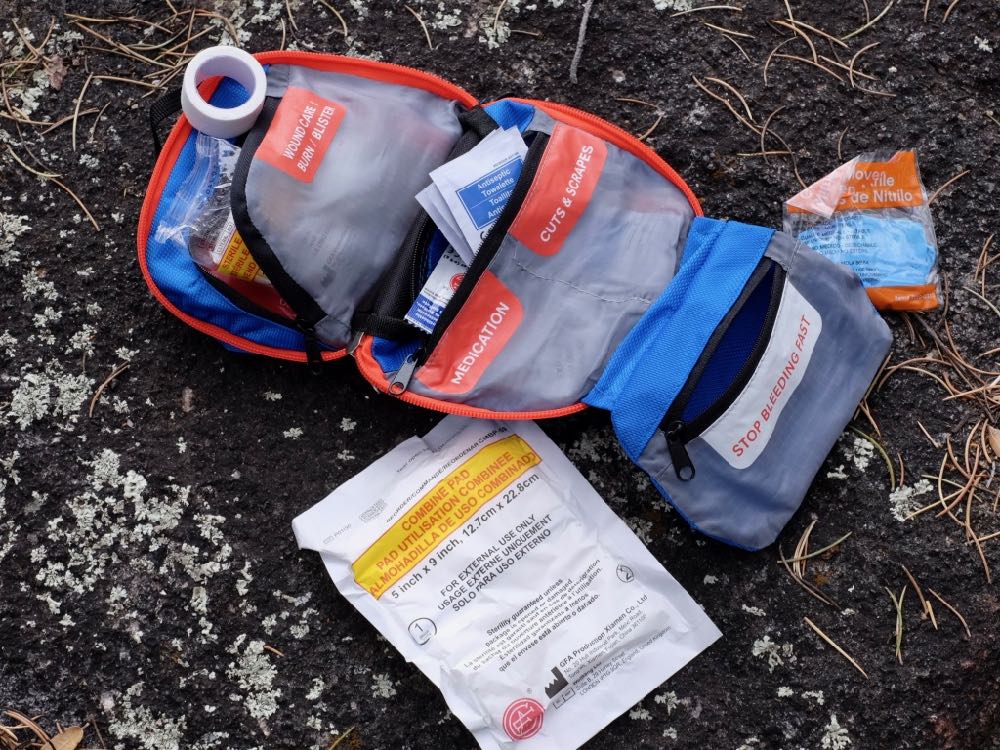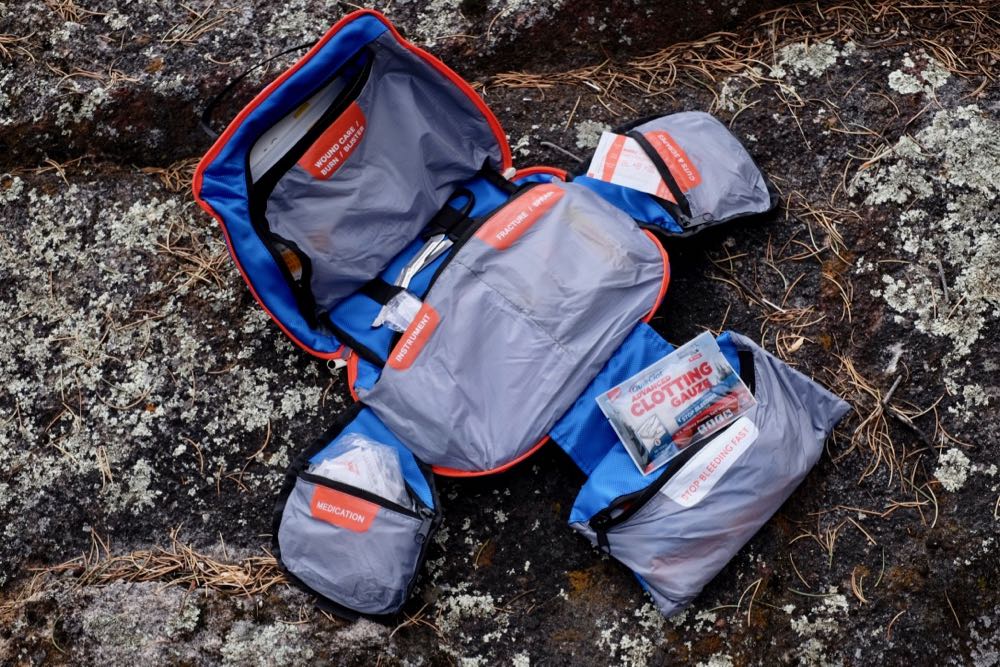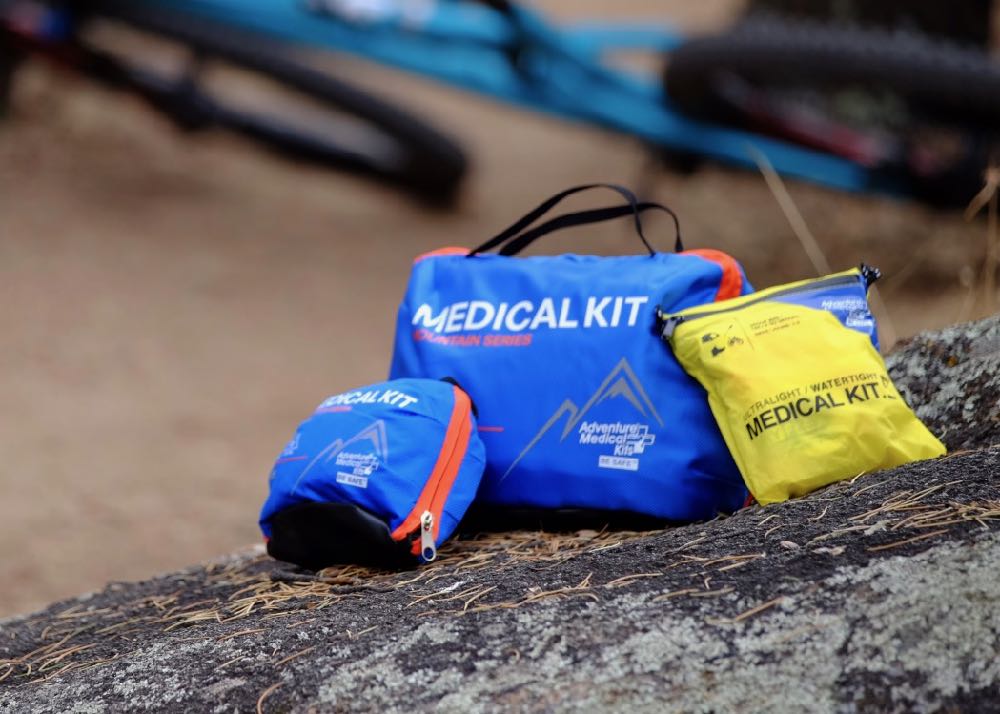Welcome to the Bikerumor First Aid Series, where we explore common cycling injuries and what to do if you or your riding partner wreck. In this installment, we look at medical kits for the trail and trailhead. Followup stories will provide in depth solutions to help you get back on the road, recommended first aid equipment to carry with you, and more. If you have specific questions, leave them in the comments and we’ll answer those in future articles.
In previous installments of our First Aid Series, we covered common mountain bike injuries. Today we look into pre-assembled kits to use on the trail or in the car. The kits we evaluated this week come from the first aid mavens at Adventure Medical Kits.
How to select a medical kit
There are three important factors to choosing a first aid kit. The most important is deciding on the scope of emergencies you need to address. For a short day on the bike you likely won’t need to tackle anything more severe than minor boo-boos. If you’re headed out on a multi-day ride through the Andes, you’ll need to beef up your remedies to treat stomach ailments, chipped teeth, eye injuries, or any other foreseeable mishap.
The number of people in your group also contributes to the demands placed on a medical kit. More people create more chances for injury. Lastly, the time in the field has to be considered. Some kits provide enough material to treat one injury, one time. If you’re going to be out for several days, you’ll need a deep inventory of dressings, bandages, and other items just to continually treat the same injury.
Here, we showcase three of our favorites from Adventure Medical Kits. We like this brand for their reputation and well thought out components. The team at AMK are also avid mountain bikers and understand the types of injuries cyclists frequently endure. You can find lesser kits at sporting goods stores, but often those are filled with, um, filler like too-small bandaids and lower quality utensils. When it comes to emergency first aid, we believe you get what you pay for…this is one area you don’t want to skimp.
On the Trail – Single Rider: Ultralight / Watertight .5

It’s tough to beat this small $20 kit. Packaged in waterproof pouch tucked into a nylon bag, it’s not much larger than a PB&J sandwich. It has all of the basics needed for minor cuts, scrapes, and stings. Although it includes butterfly strips for wound closure and modest bandaging for suspected fractures, it’s ideally suited to basic injuries. See the full inventory in the kit here. Get it on Amazon for $16.99.
On the Trail – Group Use: Mountain Series Hiker

Okay, hikers are not bikers, but this kit has just about everything you need to treat moderately serious crash injuries. A great system for group rides, it’s small enough to fit in most hydration packs. Overkill for a short hop with a few friends after work, if you’re headed out for the day with a tribe of riders, it’s worth tossing in a pack.
The Hiker has a few items to address minor injuries and even some serious cuts, abrasions, and fractures. It’s not light and clocks in at half a pound, although some of that weight belongs to the small Guide to Wilderness Medicine book. Full of useful information, I still don’t think it’s necessary to take on a ride. It is worth reading on a regular basis to keep your skills sharp.
Packaged in a zippered bag with one fold-out pouch, the various compartments are labeled with large letters to keep the contents organized and easily accessed. The small inner bag houses a trauma kit used to stop stubborn bleeds. If your group is headed out for multi-day bikepack, or camping trip, the Hiker can help remedy stomach issues, stings, and general aches and pains. It’s also a smoking deal at just $25. See the full inventory in the kit here.
At the Trailhead: Mountain Series Guide

Some people will balk at the idea of spending $100 on a medical kit. Few of those people have taken a first aid training course. Once you learn the skills required to tackle a variety of maladies, you’ll want the full assortment of tools to do so. The Guide can treat larger groups for extended periods of time. The compact nylon bag has five well-labeled compartments.
The Guide is packed with a small assortment of EMT-quality tools and supplies necessary to treat serious bleeding injuries, significant fractures, and deep cuts. An aluminum and foam C-Splint helps stabilize broken bones and a CPR face shield protects care givers responding to persons in life threatening situations. A digital thermometer is great for assessing heat stroke or hypothermia, and GlacierGel dressings are ideal for burns and deep abrasions whereby all the dermal layers have been removed.
The kit contains basic medications for allergic reactions and general aches and pains. QuickClot gauze pads help stop bleeding and high-absorption pads are available for persistent bleeds.
It’s a serious setup and at 2.15 pounds, won’t make it on a bike. Best suited for trailhead duty, the Guide never leaves my vehicle. See the full inventory in the kit here. Get it at REI for $100.
Tweaking your kit for your personal needs:
It’s always a great idea to dig into your new kit to familiarize yourself with its contents. Mountain bikers rarely suffer blisters, so that’s often the first thing I remove. It is also a good idea to add items as needed. I’m a relatively new Type 1 diabetic, so my kit has an extra glucose meter and my lifesaving jelly beans used to correct a glycemic low. Although I don’t have any serious allergies, my kits always include an epipen.
It’s worth mentioning, many first aid supplies have expiration dates. As your inventory dwindles from use and aging products, the AMK website allows users to easily reorder supplies in small and affordable quantities. And things like ibuprofen, antihistamines, bandages, and gauze can usually be pilfered from your medicine cabinet or any drug store to replace more commonly used items.
If you want to feel like a hero, get a quality medical kit, take a comprehensive first aid course, and wait for someone to break themselves. You won’t have too wait long.
Got a question about emergency first aid or care when on the trail or road side? Use our Contact Form to submit your questions and we’ll get the experts to answer them! Some links in this article may be affiliate links, which earn us a small commission if you purchase from the linked site. This doesn’t add anything to the price you pay, but helps us keep the servers running!
